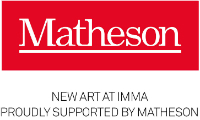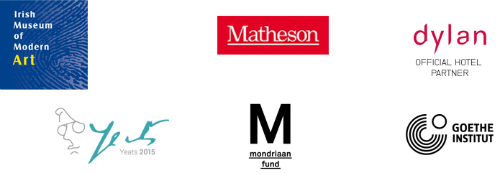On Thu 24 March 2016 IMMA launches its Spring programme with two major solo exhibitions from Irish artist Patrick Hennessy, and Italian artist Carol Rama; both born in the same decade and both neglected by the official art circles of their time. Although extremely different artists, one a realist painter, the other not faithful to any particular movement, Hennessy and Rama both explore human sexuality, gender and identity while challenging the political and social culture of their time.
Patrick Hennessy De Profundis is the first major exhibition of the work of the post-war realist painter Patrick Hennessy RHA (1915-80) since 1981. Re-examining and repositioning Hennessy’s work as part of the IMMA Modern Irish Masters Series this exhibition reflects on what Hennessy’s work might mean to audiences today.
At a time when gay men were subject to social and legal persecution for the simple fact of their sexual orientation, Hennessy and his lifelong partner Henry Robertson-Craig bravely chose to exhibit works that clearly marked them as homosexual. They have almost no peers in Irish art, but Hennessy’s late work demonstrates an engagement with the emerging international queer-art movement of the 1970s.
A prolific artist, Hennessy created portraits, landscapes, equine studies and still-lifes that found a steady market in the Irish and international art world, but he also created works unlike anything being made in Ireland at the time. Fusing realism with a Surrealist subjectivity learned in Paris, he painted human figures isolated in the landscape, male nudes and portraits of handsome African men that puzzled Irish critics who branded him ‘something of an outsider’.
‘A strange and exotic presence in Irish art’, ‘standing alone’, ‘very un-Irish’, where just some of the terms used by critics writing about Hennessy’s work in Dublin in the 60s and 70s. The label ‘Surrealist’ was generally used to explain-away Hennessy’s images that were not easily read. In reality many of his works were comprised of visual codes that signified clear narratives of homosexual life. While these codes were impenetrable to some; they were readily interpreted by those around his circle that included artists like Francis Bacon, the Two Roberts (Colquhoun & MacBryde), John Craxton and Lucian Freud; as well as the writers Elizabeth Bowen, Cyril Connolly, Brendan Behan and others.
Also opening the same day is The Passion According to Carol Rama, an exhibition of almost 200 works by artist Carol Rama (1918 – 2015). It is the largest exhibition of the artist’s work to date and comes to Dublin following exhibitions in MACBA, Barcelona, Musée d’Art moderne de la Ville de Paris, and EMMA, Finland.
Ignored for decades by official art history, Carol Rama is now recognised as essential for understanding developments within contemporary art. Her influence can be seen in the work of a later generation of artists such as Cindy Sherman, Kara Walker, Sue Williams, Kiki Smith and Elly Strik. Rama was belatedly recognised in 2003, receiving the Golden Lion at the Venice Biennale, one of the most prestigious international art exhibitions.
Divided into four thematic sections this exhibition is a guide through Rama’s many creative moments. Neither exhaustive nor retrospective, The Passion According to Carol Rama acts as an attempt to recognise and restore a life’s work still unknown but nevertheless set to become a classic.
The early work of Carol Rama, made when she was just twenty years old, is inscribed with experiences of institutional confinement and death. These works question Fascism’s heroic ideals of health and virtue while also confronting Modernism’s representations of sexuality, disability and femininity. Her watercolour figures from this period were censored as ‘obscene’ by the Italian government of 1945.
By the 1960s, Rama had moved towards the creation of ‘bricolages’: organic maps made from taxidermy eyes, fingernails, mathematical symbols, syringes and electrical circuits. Evolving her practice again in the 1970s Rama began to work with rubber from bicycle tyres; a material closely associated with her life as her father had a small bicycle factory in Turin. Rama treated rubber like a taxidermist treats skin – she dissected the tyres using them within her work to create different surfaces and textures. Punctured, flaccid, decomposing and aged by light and time, Rama’s rubber tyres are like our bodies: vulnerable material transformed by their history.
During the 1980s, Carol Rama returned to figurative modes of working – perhaps inspired by a sudden recognition of her early work by the curator Lea Vergine in 1980. She also began to identify with the figure of the ‘mad cow’ – referencing the mad cow epidemic that was sweeping across Europe at that time – and developed an animalist ethic: a kind of expanded feminism that looked beyond the centrality of humans. In doing so, Rama’s work can be seen to transcend species, gender and sexuality, and affirm a community of all living things.
Exhibition conceived by the Museu d’Art Contemporani de Barcelona (MACBA) and the Musée d’Art moderne de la Ville de Paris (MAMVP), organised by MACBA and co-produced with PARIS MUSÉES / MAMVP, EMMA – Espoo Museum of Modern Art, IMMA – the Irish Museum of Modern Art, Dublin and GAM – Galleria Civica d’Arte Moderna e Contemporanea, Torino. Curated by Teresa Grandas (MACBA) and Paul B. Preciado (documenta 14).
Fully illustrated catalogues are available to accompany these landmark exhibitions. Patrick Hennessy De Profundis is designed by Niall & Nigel at Pony with text by Seán Kissane, Curator: Exhibitions, IMMA, and contributions from art writer Robert O’Byrne, artist James Hanley and a biography Kevin A. Rutledge. The Passion According to Carol Rama includes contributions from Anne Dressen, Maurizio Cattelan, Melissa Logan and Alexandra Murray-Leslie (Chicks on Speed), Lea Vergine, Teresa Grandas, Paul B. Preciado, and an interview by Corrado Levi and Filippo Fossati with the artist, amongst others.
Both are available from the IMMA Shop, in Gallery and online
ENDS –
For further information or images please contact
Monica Cullinane E: [email protected] T: +353 (0)1 612 9921 or Patrice Molloy E: [email protected] T: +353 (0)1 612 9920
Additional Notes for Editors
About the artist – Patrick Hennessy RHA (1915-80)
Patrick Hennessy was born in County Cork in 1915 and moved with his family to Scotland in 1921. He was trained as painter in the academic tradition at Dundee College of Art, where he was greatly influenced by his tutor, the leading Scottish landscape artist James McIntosh. Hennessy excelled at Dundee and on graduating won a scholarship to travel to Europe. Between 1938-39 he went to Florence, Rome and Venice studying the work of the old masters. He then settled in Paris, the centre of Surrealism and avant-garde culture, where he worked for a time under Fernand Léger.
At the outbreak of the Second World War, he was part of the influx of artists and writers who returned to Ireland like Louis le Brocquy, Gerard Dillon, and the White Stag Group – led by Basil Rákóczi and Kenneth Hall. These outward-looking artists formed the backdrop against which Hennessy made his work.
He showed annually at the Royal Hibernian Academy and the Dublin Painters Society until the mid-50s when he was instrumental in the founding of the Ritchie Hendriks Gallery which would go on to represent some of Ireland’s leading artists. In the late 50s he gained a level of international success having regular exhibitions in the UK and North America where he found a steady market for his work. In 1959, due to ill-health he spent the winter in Tangier, Morocco. This was a turning point in his life and career as he would spend less and less time in Ireland before finally settling in Tangier in the early 70s.
The title of the exhibition, De Profundis, is taken from a painting by Hennessy that shows Dublin in ruins. It derives from Psalm 130, ‘From the depths I cry to thee O Lord’, but more notoriously it is the title of the last work of prose written by Oscar Wilde and addressed to his lover Lord Alfred Douglas. It was highly unusual for an Irish (or British) artist or writer to quote Wilde in a positive way. Wilde was synonymous with the shame that dare not speak its name and artists distanced themselves from him. Hennessy exhibited this work at the RHA in 1944 and frequently afterwards.
This exhibition re-examines and repositions Patrick Hennessey’s work as part of the IMMA Modern Irish Masters Series, a strand of programming that looks at the post-war period to shed light on artists who have been critically neglected; but also to reflect on what their work might mean to audiences today.
About the artist – Carol Rama (1915 – 2015)
Born in Turin, Carol Rama was never academically trained or faithful to any particular art movement. Instead Rama developed a body of work over seven decades that is as unique as it is obsessive. Carol Rama experimented with alternative materials, developing techniques for inventing new spaces of desire. Her work challenges dominant narratives around sexuality, madness, animalism, life and death.
Associated Events
Curators Conversation: The Passion According to Carol Rama
Wednesday 23 March, 6.30 – 7.30pm, Johnston Suite
Curators Teresa Grandas (MACBA) and Paul B. Preciado (documenta 14) explore how Rama’s work offers anarchic representations of female sexuality, gender and politics which allow an essential revision of avant-garde movements of the last century. Followed by the exhibition preview and opening party. This talk is free but booking is required. Book now
Modern Irish Masters Series| Patrick Hennessy De Profundis
Sun 10 April, 3 — 4pm / Johnston Suite / FREE
Seán Kissane (Curator, Exhibitions, IMMA) presents a keynote lecture offering a new perspective on the work of Irish artist Patrick Hennessy. This talk will give rich insights into Hennessy’s images which address themes such as war, religion, gender and sexuality. This talk is free but booking is required. Book now
Curators Lunchtime Talks
Join IMMA curators for insightful exhibition walkthroughs, where a thematic selection of artworks are explored in detail. These talks are free and no booking is required, just turn up on the day.
Friday 6 May, 1.15 – 2pm / Meeting Point, Main Reception / FREE
The Passion According to Carol Rama with Rachael Thomas, Head of Exhibitions, IMMA.
Saturday 23 July, 1.15 – 2pm / Meeting Point, Main Reception / FREE
Patrick Hennessy De Profundis with Seán Kissane, Curator: Exhibitions, IMMA.
Seminar | Gender, Identity and the State, Date to be announced
Comprising of presentations by artists, writers, curators and educators, this seminar address issues of gender, sexuality, identity and the state as it relates to the work of artists Hennessy, Rama and others. Participants will draw on critical and queer theory across a wide range of disciplines. Further details to be announced.
,_1985_(oil_on_canvas),_freud,_lucian.jpg)




